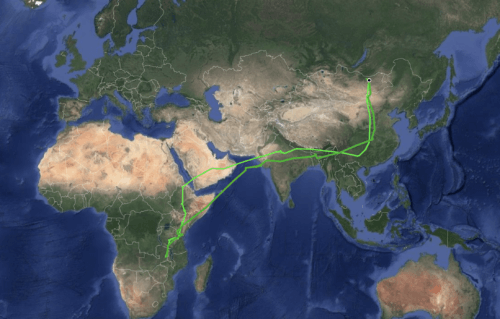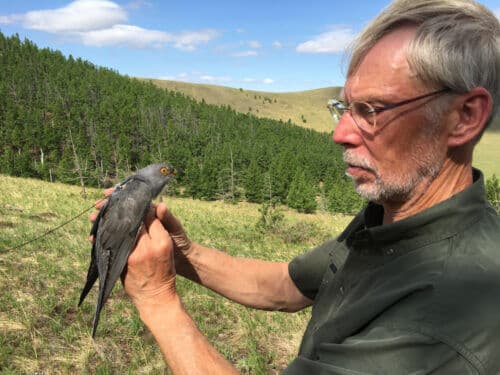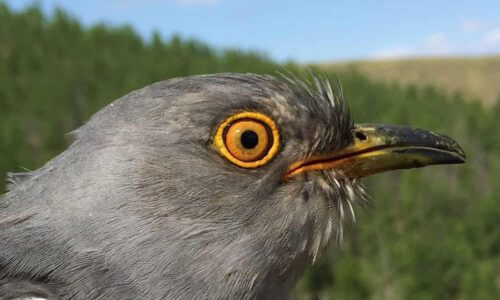A particularly energetic cuckoo crossed 26 thousand kilometers in the last year and visited 16 countries. Along the way, she became an international network star and provided more important information about the migratory patterns of the world's birds
For many of us, on summer days without foreign countries, the longing for flights skyrockets. In Taiwan, for example, these longings have recently created a trend of "flights to nowhere", which include check-in, duty free, take-off and landing, but end two hours later at the same airport where they started.
However, while we are grounded, the winged animals around us fly at will, crossing international borders and not wearing mouth or nose masks. One such impressive journey was recently documented when a particularly active male cuckoo flew all the way from East Asia to the south of Africa and back, for no less than 26 thousand kilometers, and swept away many enthusiastic followers from around the world.
The constant traveler's name is Onon (after a river that flows in Mongolia), and he belongs to a species of European cuckoo (which is also found in Israel). Onon took off in June 2019 from Emek Hora in Mongolia with a tiny transmitter attached to his body, and by the time he returned to Mongolia, on May 27, 2020, he had crossed international border lines 27 times and visited a total of 16 countries, the most distant being Zambia.

Onon is one of five cuckoos whose migration was recorded in a special project, which included three birds of the European cuckoo species and one of the Oriental Cuckoo species, but he is the only one whose return was also recorded. The fate of the other birds is unknown: they may not have survived the long and difficult journey, or their transmitters simply stopped working.
Onon's journey attracted a lot of attention among surfers from around the world. His migration could be tracked in real time Web site וon the Twitter page of the project, and many surfers asked curious questions about Onon and his journey. The local schools in Mongolia were also involved in the process, and they helped choose the names given to the cuckoos and followed the migration as part of their studies.
In May, when Onon returned, he appeared on Mongolian television and press, becoming a celebrity outside the country as well. Today, he spends his days in Horach Valley, where he faces tasks as important as migration: protecting his property from competing males and mating with as many females as possible.
She is the cuckoo
The cuckoos are named in Hebrew and in many different languages after the unique sound produced by the male, the same "cuckoo" that is also known from the cuckoo clocks from which their figure emerges. The cuckoo is known for not raising its own chicks: it lays its eggs in the nests of birds of other species, and continues on its way. The cuckoo chicks hatch shortly before the others, and they push the other eggs out of the nest. Thus, the mother feeds only the cuckoo chick, which sometimes even reaches larger dimensions than its "adopting" mother. In Israel, besides the European cuckoo, you can also find the crested cuckoo, which is more common in the country, and whose chicks are often raised in the nests of gray crows.
The cuckoos migrate in search of their main food: the larvae, which are mostly found in warm and rainy places. Many European cuckoos spend the summer in the Khore Valley in Mongolia. When the weather changes, they migrate to India, where they stay during the monsoon season. When it ends they continue to East Africa, and when summer starts again in the Northern Hemisphere they return back to Mongolia.
"Onon's journey is certainly an impressive achievement, these are not small distances for such a bird," says Prof. Yossi Leshem, a bird researcher in the Department of Zoology at Tel Aviv University and the Society for the Protection of Nature. According to him, until the last few years, such surveillance was not possible. "The weight of the transmitter cannot exceed 4 percent of the bird's weight," he says. "In the past, the transmitter weighed 70 grams, so it was possible to attach transmitters only to large birds, such as storks, eagles or eagles, and not to cuckoos, which are relatively small birds." A European cuckoo weighs About 130-110 grams, so such a transmitter would definitely burden her. "Today there are much smaller transmitters, so it is possible to track even smaller birds," says Leshem.

Birds in the sky of Israel
Bird migration is a well-known phenomenon from the skies of Israel. "Israel is one of the most special places in the world in terms of bird migration, 500 million birds pass over us twice a year," says Leshem. As a result, we also monitor migrating birds. An example of such a study is the monitoring of about 120 chassidites, which he conducted there as part of a collaboration between Tel Aviv University and the Max Planck Institute for Ornithology in Germany. "We also integrated the education system into the project, and students could follow the traveling Hasids online," he says.
One of the known birds from the study was the Hasida Princess, which also received media attention in Israel and Germany. "For no less than 13 consecutive years, Princessa flew from Germany to South Africa and back, a journey whose total length is 22 kilometers, and every year she returned at the same time and to the exact same nest," says Leshem.
Another bird tracking project that is currently active is "Birds of prey live", in the framework of which cameras placed in the nests of birds of the eagle, eagle, eagle, and hawk species broadcast what is happening online 24 hours a day, with the aim of exposing the public to the lives of the birds and their importance and in order to generate insights for the protection of the sensitive birds. Last month, the transmitter carried by one of the female eagles (a bird that is in serious danger of extinction in Israel) that was recorded as part of the project stopped working, and the researchers discovered that she was unfortunately electrocuted to death. The video surveillance of the orphaned chick from the female's mother allowed the researchers to examine the amount of food it receives from its father, who is left alone with the chick, and after much thought about solutions that would allow the vulnerable chick to survive despite the loss of its mother, it was decided to take a creative step and for the first time in the world Provide food to the chick using a drone.
For the sake of the birds, for the sake of man
The cuckoos are not defined as a vulnerable or endangered species, but their numbers are there in a downward trend, and if the availability of food in their migration sites decreases, due to the effects of the climate crisis, for example, or due to other effects of human actions such as damage and destruction of habitats, this may endanger them. Therefore, monitoring them and other birds is of great importance, because they gather information about their condition and raise public awareness of the difficulties faced by the animals.

Beyond that, understanding the actions of the birds is critical in order for humans not to be harmed by their natural behavior. Thus, for example, a study on the characteristics of bird migration in Israel that he conducted there in the 80s led to a change in the training procedures of the Israeli Air Force, whose planes were often involved in accidents with birds. "We reduced the number of accidents between planes and birds in the Air Force by 76 percent and saved a billion and a half dollars and of course many human lives," he says.
Lesem emphasizes that the study of birds has been of great benefit to man throughout history. "All human flight is an imitation of the flight of birds, they contribute a lot to human knowledge", he concludes.
the post Cuckoo without borders appeared first onangle
More of the topic in Hayadan:
